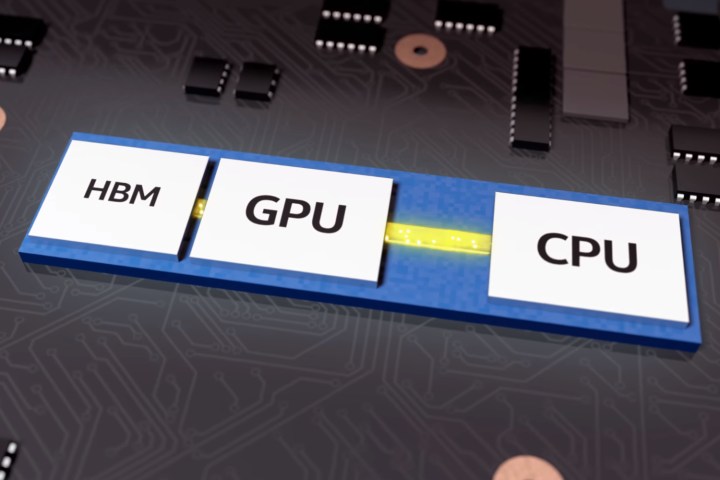
Here are the specifications:
| Model: | Core i7-8809G |
| Cores: | 4 |
| Threads: | 8 |
| Base speed: | 3.1GHz |
| Cache: | 8MB |
| Max power consumption: | 100 watts (target use) |
| Supported memory type: | DDR4 @ 2,400 dual-channel |
| Graphics: | Radeon RX Vega M GH Graphics Intel HD Graphics 630 |
Keep in mind that the Core i7-8809G is a module, and not a processor cramming AMD’s graphics cores into the typical CPU package. There will be three chips mounted on a small, enclosed circuit board with an embedded “superhighway” that connects all three together. One chip will contain the CPU and what appears to be HD Graphics 630 graphics cores, one will contain the Radeon cores, and the third will play host to HBM2 memory dedicated to the Radeon graphics.
The leaked specs show that the processor cores are likely based on Intel’s seventh-generation Kaby Lake architecture, and not the most-recent Coffee Lake design. The clue is in the integrated HD Graphics 630 component, which was tweaked and renamed as UHD Graphics 630 in the new eighth-generation Core processors. The memory support is also a clue given it matches Kaby Lake while Coffee Lake supports DDR4 memory at 2,666MHz.
That said, the part number may bear an eighth-generation number, but it’s likely based on an eighth-generation design. What’s interesting is that internet sleuths found the unannounced module listed among unlocked desktop processors that sit on motherboards the old-fashioned way — via a socket. There are also no mobile chips on the list, indicating that Intel classifies the upcoming module as a desktop product that may be seated/unseated just like any other desktop processor.
But current renders and possible leaked images show the module to be rectangular in shape whereas desktop processors are typically squared. That means the module likely isn’t compatible with any eighth-generation motherboard unless Intel’s renders are for illustration only, and don’t reflect the product’s final shape. Intel may also take the Atom route by locking the module in place, thus the only way to get the Core i7-8809G is to buy the complete chip/motherboard package.
As for the 100-watt power use, that’s the combined power draw of the CPU cores, Intel graphics cores, Radeon graphics cores, and HBM2 memory. Speculation points to 45 watts for Intel’s portion followed by around 50 watts for AMD’s graphics. The Radeon aspect could contain up to 24 compute units given that AMD already crams 10 “Vega” CUs in its Ryzen 7 2700U all-in-one processor (APU). AMD’s chip only consumes 15 watts of power.
Given that CES 2018 starts next week, we should have a clearer picture regarding Intel’s collaboration with AMD during the show.



